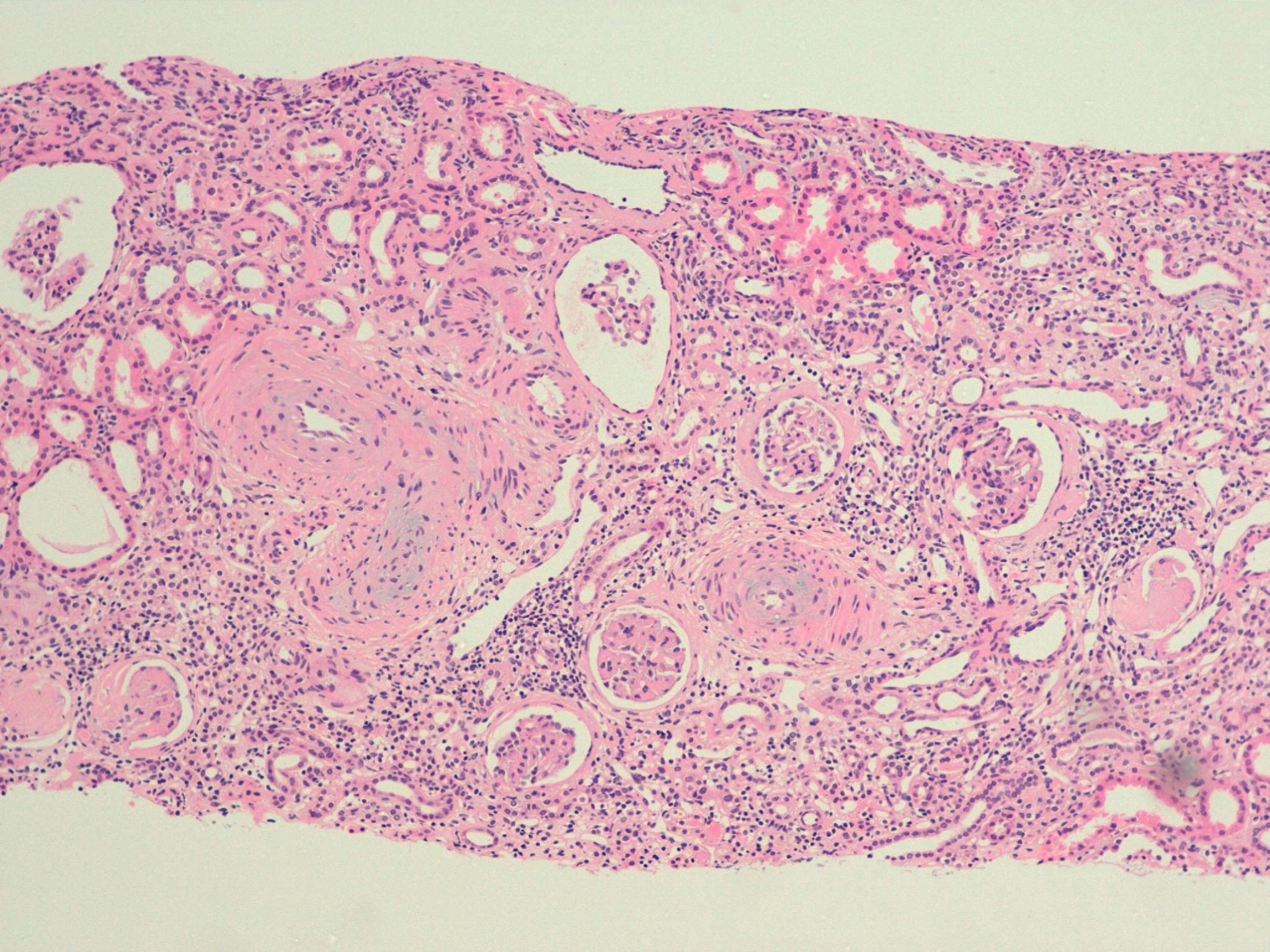To the Editor,
Cocaine use is associated with multiple complications, the most common being cardiovascular and neurological disorders.1 In recent years, knowledge about the role of cocaine in acute and chronic kidney injuries has increased. Regular and continual use can lead to severe arterial hypertension (AH) and terminal chronic renal failure.2-5
We present the case of a 26-year-old man, a habitual user of inhaled cocaine for 6 years, seen at the emergency department with dyspnoea on minimal exertion and headaches. He had a blood pressure of 200/110 mm Hg, a chest x-ray with butterfly pattern and a plasma creatinine level of 10 mg/dl. Creatinine kinase levels were normal, and neither microhematuria nor proteinuria were found. The patient denied having taken cocaine in the last month due to his worsening general health, but a urine sample was not taken to rule it out. Haemodialysis was begun via a right jugular catheter with evident clinical improvement. Of note in his medical history were 2 admissions to another hospital. The first was 2.5 years earlier due to a hypertensive emergency with acute pulmonary oedema requiring oral tracheal intubation and mechanical ventilation. He was also suffering from acute renal failure with a plasma creatinine level of 5 mg/dl in the context of rhabdomyolysis after inhaling cocaine. Doppler echocardiography showed severe concentric hypertrophy of the left ventricle and moderately depressed systolic function. The Doppler echocardiogram and catecholamine levels were normal. Kidney function recovered completely without dialysis. The second admission, 6 months before this one, was due to chest pain after consuming cocaine; the level of troponin enzymes was normal, but level of plasma creatinine of 2.3 mg/dl remained high. Therefore, the patient continued to take irbesartan, amlodipine, carvedilol, and torsemide to control his blood pressure. Later, the patient stopped having medical check-ups. Six months after beginning dialysis, with no improvement in renal function, a kidney biopsy was performed which showed that 10% of the glomeruli had global sclerosis, and the rest showed varying degrees of mesangial expansion, 12% with segmental hyalinosis, and 40% with moderate fibrosis of Bowman’s capsule. The medium and small-sized arteries showed significant lumen reduction with hyalinization of the intima and media, and intimal proliferation (Figure 1). Immunofluorescence was negative. After 8 months without using cocaine, the patient had stable blood pressure of 135/85 mm Hg and needed treatment with 5 antihypertensive drugs and haemodialysis 3 times per week.
The most common kidney complications due to cocaine abuse are rhabdomyolysis or severe AHT.2 The mechanism linking cocaine with rhabdomyolysis is unclear, but it could involve ischemia due to vasoconstriction and vasospasm caused by cocaine’s sympathomimetic action. This triggers tissue hypoxia with myocytic necrosis, direct muscle toxicity, hyperpyrexia, and an increase in muscle activity with repeated trauma due to the agitation after consumption.2,6 Chronic cocaine use sets in motion chronic and haemodynamic changes mediated by the increase in oxidative stress and the stimulation of the renin-angiotensin system, which lead to an increase in mesangial expansion, tubulointerstitial fibrosis, and greater atherogenesis.4,5 Furthermore, chronic cocaine use can cause a permanent circle of vasoconstriction, AHT, and kidney failure.7 Blood pressure can be extremely high and often related to the degree of kidney disease, and it can be resistant to treatment.2
This is the first case in our hospital of chronic kidney failure with the need for replacement therapy due to cocaine use. It is also worth highlighting in the patient’s medical history a proven episode of acute kidney failure due to rhabdomyolysis and severe, hard-to-control AHT. He also suffered from heart disease in the form of severe hypertrophy of the left ventricle with a depressed ejection fraction; a pathology described in and related with cocaine consumption. Besides, cocaine is known to lead to ischaemic cardiomyopathy in the form of angina pectoris, acute myocardial infarction, and episodes of cardiac arrest due to arrhythmias, even occurring in sporadic or one-off cocaine users.8
As nephrologists, it is necessary to understand the extensive range of diseases that cocaine can produce in the kidneys, taking into consideration its high, ever-increasing rates of consumption.
Figure 1. Arteries with significant lumen reduction due to the hyalinization and proliferation of the intima and media








